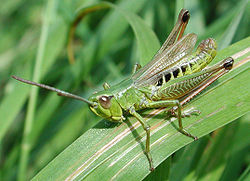| Pseudochorthippus parallelus | |
|---|---|
 | |
| Male | |
 | |
| Female | |
| Scientific classification | |
| Kingdom: | Animalia |
| Phylum: | Arthropoda |
| Class: | Insecta |
| Order: | Orthoptera |
| Suborder: | Caelifera |
| Family: | Acrididae |
| Subfamily: | Gomphocerinae |
| Tribe: | Gomphocerini |
| Genus: | Pseudochorthippus |
| Species: | P. parallelus |
| Binomial name | |
| Pseudochorthippus parallelus (Zetterstedt, 1821) | |
| Synonyms | |
| |
Pseudochorthippus parallelus [2] (often known by its synonym Chorthippus parallelus), the meadow grasshopper, [3] is a common species of grasshopper in the tribe Gomphocerini. [4] It is found in non-arid grasslands throughout the well vegetated areas of Europe and some adjoining areas of Asia. It is a well-studied organism in the discipline of evolutionary biology and was an early and important model system for the study of European phylogeography.








